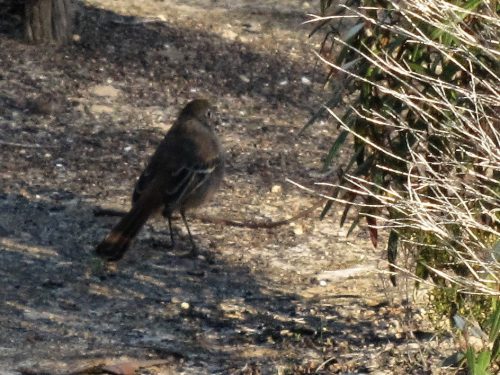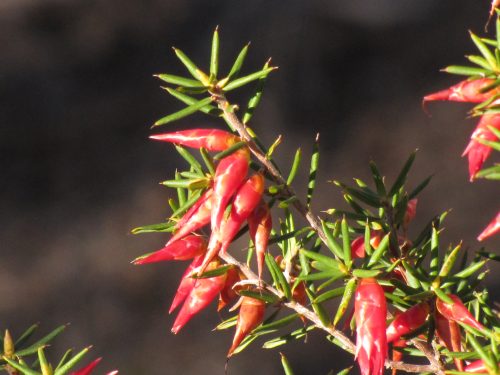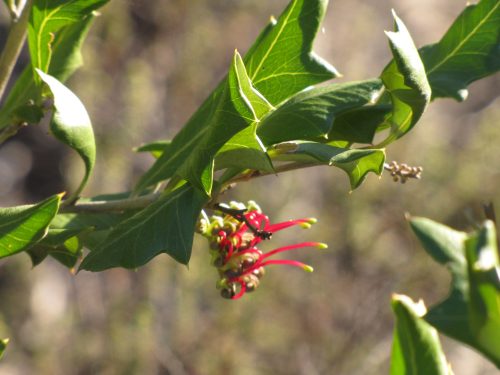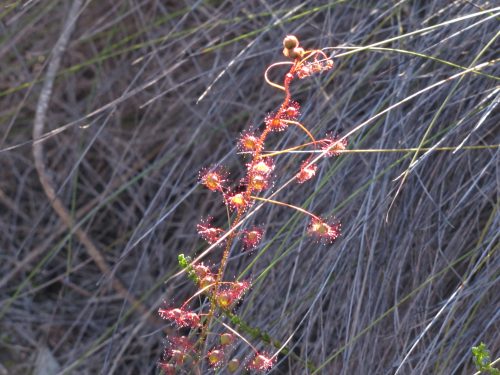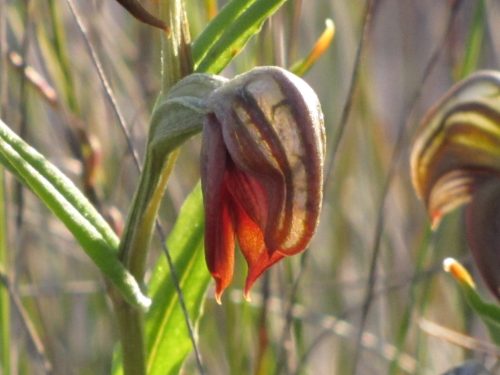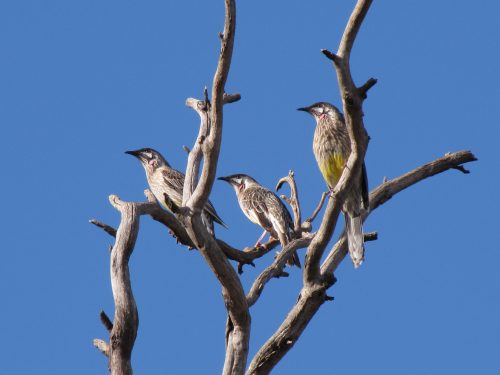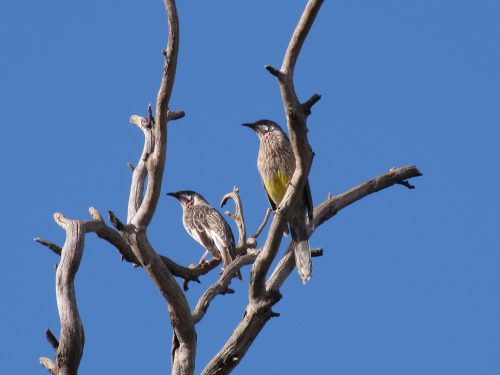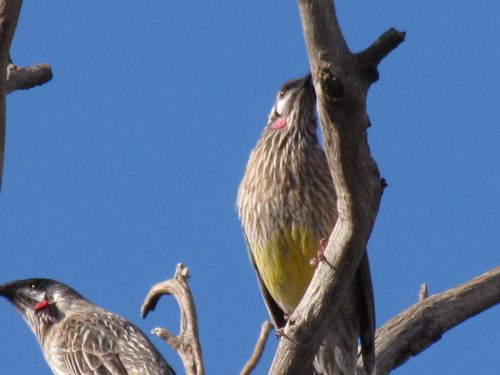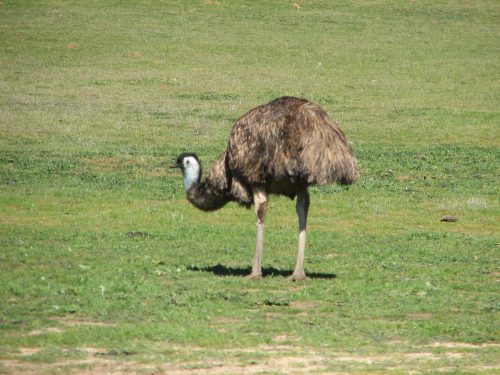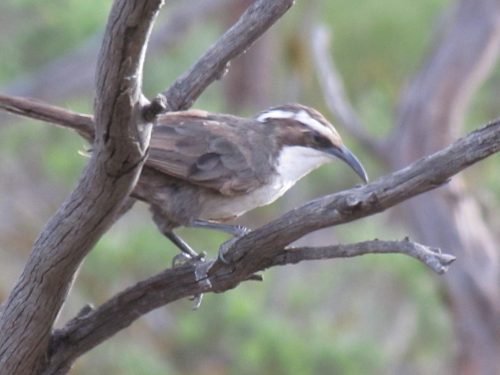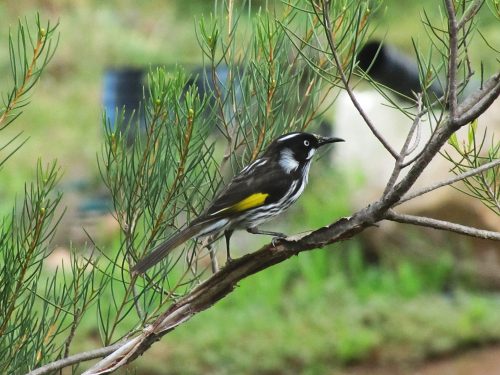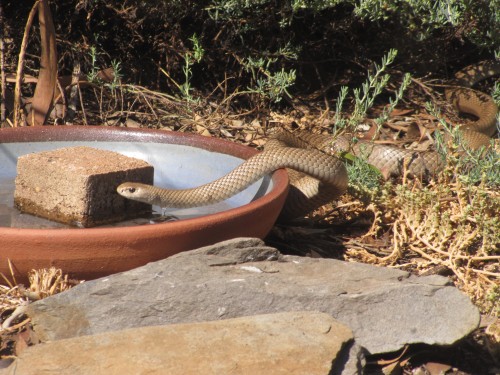A visit to Monarto Conservation Park
A few months ago my wife and I paid a visit to the Monarto Conservation Park in South Australia. This park is south-east of Adelaide and south-west of Murray Bridge where we live. It is about a twenty-minute drive from home. The park is mainly mallee scrub but it contains a good range of small and medium-size native wildflowers, some of which I have shown in the photos below.
On the day we visited, I did not see or hear all that many birds. This is not unusual; some days are like that and very few are seen, while other days you don’t know where to look first – there are so many birds to watch. On this occasion, the only bird I managed a reasonable photo of is the Southern Scrub-robin shown in the photo above. I have found this species to be a somewhat shy bird that skulks in the undergrowth. I followed this individual for about five minutes before it disappeared from view. I could hear it – and others – calling from time to time, but none of them came out in the open to enable a better shot.
This park boasts a wide range of native Australian wildflowers. There always seems to be something flowering, so honeyeaters are common in the park. One can also expect to see, or hear, both types of Pardalote, several species of pigeons, parrots and lorikeets, as well as the elusive Shy Heathwren. Fairy-wrens are also common in the park, as are several species of birds of prey, usually seen soaring overhead. You can also see Australian Magpies, Grey Currawongs, Little Ravens, Grey Butcherbirds and several kinds of swallows.
Access to the park is via Ferries-McDonald Road, a sealed road off the South-eastern Freeway. There is a carpark on the right as you travel south. There are no facilities in or roads through the park, but there is a well-defined walking track starting at the carpark. This is an easy 45-minute walk through a variety of habitats in the north-eastern corner of the park. All of the photos featured today were taken along this walking track in early July of 2017.
I was swooped by a wattlebird
On our trip to Sydney last week, we stopped for a brief rest at the Wagga Wagga Botanic Gardens. This is one of our favourite stopping places on our way from home in Murray Bridge, South Australia, when we are going to Sydney to visit family. On this occasion, we stopped there to have morning tea, and to change drivers.
The botanic gardens in Wagga Wagga have a good representative range of both Australian and exotic plants. The gardens are beautifully set out with plenty of areas of lawn for visitors to have picnics. The good range of plants means that visitors can see something flowering at most times of the year. This also means that there is also a good range of birds present in the gardens and the surrounding environment no matter when one visits.
On this occasion, we were somewhat pressed for time, so I only had the chance to make a small list of the birds I saw. I didn’t even get my camera out, so the photos in today’s post were taken a few weeks ago near our home. I was in the middle of having a cup of tea and looking around at the flowering Grevilleas and Callistomens in the Australian Native Garden section.
I saw a Red Wattlebird land in the bush next to me. I thought it was about to feed on the many flowers in this bush. Instead, as it perched there, it screeched at me – as if it was growling at me. It flew off briefly, returning very low over my head and clacking its beak as it again flew into the bush. It repeated this action several times, each time swooping low over my head. It seemed to be irritated by my presence.
Its next action revealed its true intention. A small crumb from my piece of cake fell to the ground. Immediately, the Wattlebird swooped down and picked it up. It was obviously calling to me to feed it some cake. I guess many visitors do feed the birds during their picnics. In Australia, this is discouraged because many forms of human food are actually harmful to our birds. There is no reason to feed our birds because they have access to a wide range of natural foods.
The most interesting thing about this close encounter was that this individual had learned to swoop humans in order to get food handed to it. I have been swooped by Wattlebirds before, but it is a fairly rare occurrence in my experience.
Good birding,
Trevor
Further reading:
- The problem of swooping magpies
- Do Blackbirds swoop? Dealing with aggressive birds.
- Pesky Plovers – dealing with swooping birds
Where are all the Emus?
Recently we began another road trip, once again visiting family in Sydney. From home in Murray Bridge, South Australia, it is just over 1300 kilometres or about 14 hours actual travelling time. Whenever we stop, I try to jot down a list of all of the birds I see or hear. When it is my wife’s turn to drive, I am able to concentrate on the birds I see as we are driving along, listing them in my notebook as I see the birds. Sometimes, if I see something unusual, or noteworthy, I will even ask my wife to note this in my notebook when I am driving. She is great that way – and she even points out birds I may have missed.
On all of our trips over to Sydney, I particularly enjoy crossing the Hay Plains between the towns of Balranald and Hay. To most people, this is a dreary, featureless plain covered by saltbush. We find it endlessly fascinating, watching the subtle changes in vegetation as well as the birdlife along the way. On this trip, we saw quite a few birds of prey, something which is not surprising due to the frequent encounters with roadkill. Many kangaroos, rabbits and foxes are killed by the hundreds of trucks traversing this route day and night. We saw plenty of Black Kites, Black-shouldered Kites and Nankeen Kestrels but no Wedge-tailed Eagles which is surprising.
Of particular note, however, was the lack of Emus. Normally we see dozens of this species, sometimes more than a hundred, often in small, loose flocks of 5 to 10 birds. Occasionally, we even see a male Emu followed by a group of up to a dozen immature birds. (The male incubates the eggs and cares for the young for up to 6 months after hatching.)
This time the grand total of Emus was one. In fact, it was the only Emu for the entire 1300km journey.
I cannot account for the absence of Emus on this trip. Perhaps there was no food for them near the road, or they are nesting away from the road. Maybe we will see more on our return trip in three weeks’ time.
Further reading:
- Emu article on Birds in Backyards site – plenty more information about this species.
- Young Emus
- Emu at Adelaide Zoo
- Baby Emus come to drink
- Do Emus Swim?
Babblers building a nest
The White-browed Babbler is a common bird species around where I live in Murray Bridge, South Australia. They could almost be considered as a resident species in our garden and on our five-acre block of land, but we don’t see them every day. Frequently – but not every day. Their range must be larger than just our property.
A few days ago my wife and I had been out for the morning. I drove down the driveway and we stopped in the car for a few minutes to enjoy the warmth of the sunshine. It was a cold, blustery day with occasional showers. As we sat there chatting, we noticed a White-browed Babbler hopping along the driveway in front of the car. It had a few small twigs in its beak and was pecking at the ground, collecting more twigs. As it flew towards us, it looked like it had whiskers sticking out from its beak.
The bird flew immediately into the Grevillia bush next to the car. We immediately realised that it had been carrying nesting material. After a minute or so, we saw it fly out of the bush to another spot in the garden where it started collecting more twigs. While it was gone, I went to the bush and easily found the partly made nest. I did not linger long because the nesting building bird was on its way back to the nest.
Over the next few days, the Babblers in our garden busily kept working on the nest. I had another peek into the bush the day before we left on our four week trip to Sydney. The nest then looked complete, but I did not want to hang around too long to check whether any eggs had been deposited in the nest. If there are eggs in there, they will probably hatch out before we return home. We may be just in time to see the new hatchlings when we return.
Further reading:
- White-browed Babblers
- White-browed Babblers and water
- White-browed Babblers – one of my earlier posts written over 10 years ago.
Upset New Holland Honeyeaters
Last week my wife and I were sitting on our back veranda having lunch. We were enjoying a brief burst of spring weather and the sun was most welcome. We have had a long stretch of very cold, showery, wintery weather for well over a month, so the change was very much appreciated.
I often have my binoculars at the ready in case I want to check out any of the many birds we see in our garden. Sometimes I even have my camera at the ready, too. As we were enjoying a cup of tea after lunch, a flock of about a dozen New Holland Honeyeaters set up a terrible racket in the bushes about ten metres from where we were sitting. I immediately thought that their warning calls meant that there was a bird of prey in the sky overhead, or else it was in the trees nearby.
On looking around, and checking the sky, I could not see any evidence of anything they could be getting upset over. All of the honeyeaters kept calling and fluttering around, obviously quite agitated by something on the ground. I cautiously walked towards them. They took no notice of my presence and kept calling loudly.
Snake!
A metre long Eastern Brown Snake was trying to stay inconspicuous in the shadows, but I caught a glimpse of it as it made its escape into the undergrowth – and away from the keen eyes of the resident honeyeaters. I slowly made my retreat, intent on not getting too close to one of the world’s deadliest reptiles right there in our garden.
Every summer we usually see one or two Brown Snakes in our garden, on our five-acre property, or crossing the road leading to our home. We usually give them a wide berth when we see one and never try to get too close. They don’t bother us and we don’t bother them. I prefer to let them be because not only are they protected under our laws, they also do us the service of keeping mice and rat numbers down to a manageable level. My only concern was that this was rather early in spring for our first sighting; summer won’t start until December.
I guess that we will have to keep an eye out for them in the coming months. Proceed with caution.
Further reading:
- Bird baths are not just for birds – this post includes photos of a Brown Snake at one of our bird baths,
- Brown Snakes and Woodswallows
- Beautiful birds, leaping lizards and slithering snakes
